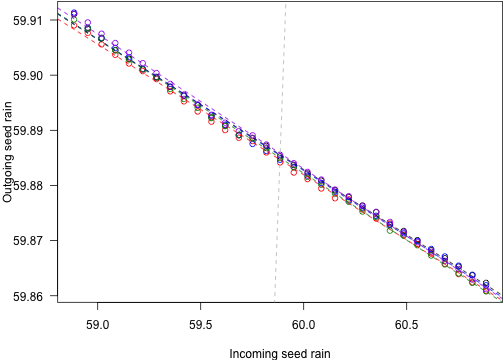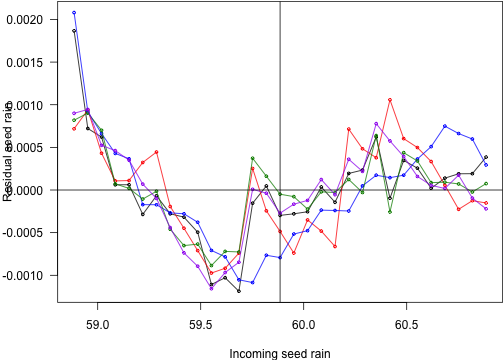-
Notifications
You must be signed in to change notification settings - Fork 20
instability
library(tree)library(parallel)With the current model/set of parameters, things here are nowhere near as bad as they used to be. However, there is still some useful information here.
Try to establish what the equilubrium seed rain is.
p <- ebt_base_parameters()p$add_strategy(new(Strategy))p$seed_rain <- 1.1 # Starting rain.run <- function(seed_rain_in, p, schedule) {
p$seed_rain <- seed_rain_in
run_ebt(p, schedule)$seed_rains
}run_collect <- function(seed_rain_in, p, schedule) {
p$seed_rain <- seed_rain_in
run_ebt_collect(p, schedule)
}run_new_schedule <- function(w, p, schedule=NULL) {
p$seed_rain <- w
res <- build_schedule(p, schedule)
unname(attr(res, "seed_rain")[,"out"])
}res <- equilibrium_seed_rain(p)## 1: Splitting {34} times (141)
## 2: Splitting {12} times (175)
## *** 1: {1.1} -> {70.94} (delta = {69.84})
## 1: Splitting {44} times (141)
## 2: Splitting {34} times (185)
## 3: Splitting {24} times (219)
## 4: Splitting {14} times (243)
## 5: Splitting {3} times (257)
## *** 2: {70.94} -> {59.62} (delta = {-11.31})
## 1: Splitting {42} times (141)
## 2: Splitting {33} times (183)
## 3: Splitting {26} times (216)
## 4: Splitting {15} times (242)
## 5: Splitting {2} times (257)
## *** 3: {59.62} -> {59.89} (delta = {0.2692})
## *** 4: {59.89} -> {59.89} (delta = {-0.005533})
## *** 5: {59.89} -> {59.89} (delta = {3.182e-05})
## *** 6: {59.89} -> {59.89} (delta = {-7.99e-07})
## Reached target accuracy (delta 7.98969e-07 < 1.00000e-05 eps)
seed_rain_eq_in <- unname(res[["seed_rain"]][,"in"])seed_rain_eq_out <- unname(res[["seed_rain"]][,"out"])schedule1 <- res[["schedule"]]$copy()approach <- t(sapply(attr(res, "progress"), "[[", "seed_rain"))Sanity and time check
system.time(cmp <- run(seed_rain_eq_in, p, schedule1)) # ~10s## user system elapsed
## 5.680 0.023 5.801
cmp - seed_rain_eq_out # should be exactly zero## [1] 0
Check that running the ebt with collection does not change things:
system.time(res_cmp <- run_collect(seed_rain_eq_in, p, schedule1)) # ~13s## user system elapsed
## 7.088 0.036 7.251
res_cmp$seed_rain - seed_rain_eq_out## [1] 0
Then, in the vinicity of the root we should look at what the curve actually looks like, without adaptive refinement.
dr <- 1 # range of input to vary (plus and minus this many seeds)seed_rain_in <- seq(seed_rain_eq_in - dr,
seed_rain_eq_in + dr, length=31)seed_rain_out <- unlist(mclapply(seed_rain_in, run, p, schedule1))fit <- lm(seed_rain_out ~ seed_rain_in)p2 <- p$copy() # modify fast controlp2$set_control_parameters(list(environment_light_tol=1e-6))system.time(cmp2 <- run(seed_rain_eq_in, p2, schedule1)) # ~20s## user system elapsed
## 19.286 0.062 19.764
seed_rain_out2 <- unlist(mclapply(seed_rain_in, run, p2, schedule1))fit2 <- lm(seed_rain_out2 ~ seed_rain_in)p3 <- p$copy() # modify fast controlp3$set_control_parameters(list(ode_tol_rel=1e-5, ode_tol_abs=1e-5))system.time(cmp3 <- run(seed_rain_eq_in, p3, schedule1)) # ~21s## user system elapsed
## 15.957 0.053 16.933
seed_rain_out3 <- unlist(mclapply(seed_rain_in, run, p3, schedule1))fit3 <- lm(seed_rain_out3 ~ seed_rain_in)p4 <- p$copy() # modify fast controlp4$set_control_parameters(list(plant_assimilation_rule=61))system.time(cmp4 <- run(seed_rain_eq_in, p4, schedule1)) # ~13s## user system elapsed
## 10.49 0.03 10.59
seed_rain_out4 <- unlist(mclapply(seed_rain_in, run, p4, schedule1))fit4 <- lm(seed_rain_out4 ~ seed_rain_in)p5 <- p2$copy() # modify high-precision light environmentp5$set_control_parameters(list(plant_assimilation_rule=61))system.time(cmp5 <- run(seed_rain_eq_in, p5, schedule1)) # ~24s## user system elapsed
## 24.701 0.051 25.059
seed_rain_out5 <- unlist(mclapply(seed_rain_in, run, p5, schedule1))fit5 <- lm(seed_rain_out5 ~ seed_rain_in)# fast, better light environment, better ode, better assimilation,# better assimilation and better light environmentcols <- c("black", "red", "blue", "green4", "purple")Here is input seeds vs output seeds:
matplot(seed_rain_in,
cbind(seed_rain_out, seed_rain_out2, seed_rain_out3,
seed_rain_out4, seed_rain_out5),
col=cols, las=1, pch=1,
xlab="Incoming seed rain", ylab="Outgoing seed rain")abline(0, 1, lty=2, col="grey")abline(fit, lty=2, col=cols[1])abline(fit2, lty=2, col=cols[2])abline(fit3, lty=2, col=cols[3])abline(fit4, lty=2, col=cols[4])abline(fit5, lty=2, col=cols[5])
The instability is easier to see here. There are two patterns; the blue and black lines (using the low order integration) have a switch point. The other cases have less systematic error, though general error on the same order. Oddly increasing both the assimilation integration order and the light environment sensitivity did worse than just increasing the light environment sensitivity.
matplot(seed_rain_in,
cbind(resid(fit), resid(fit2), resid(fit3), resid(fit4), resid(fit5)),
xlab="Incoming seed rain", ylab="Residual seed rain",
las=1, pch=1, col=cols, type="o", lty=1, cex=.5)abline(h=0, v=seed_rain_eq_in)